Dealing With Dehydration, Heatstroke And Heat Shock Proteins In Wildlife
Ron Hines DVM PhD
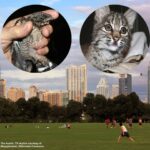 All Of Dr. Hines’ Other Wildlife Rehab Articles
All Of Dr. Hines’ Other Wildlife Rehab Articles
Dehydration
The high body temperature and high body surface area of baby wildlife, in comparison to their body weight, make them very susceptible to dehydration. Nestlings are also entirely dependent on frequent feeding of water-rich insects by their parents to maintain normal fluid balance. Once dehydrated due to falling from its nest or parental abandonment, the concentration of the various “salts” (electrolytes) in its body increase quickly to toxic levels – a failure in osmoregulation. If these electrolytes (sodium, calcium, potassium, chloride, phosphate, and magnesium) are even moderately out of balance, none of the nestling’s organs function properly. So death may soon follow.
A bird’s kidneys also play an important part in keeping water and electrolyte in balance. When water in the body is too scarce, little urine is produced. When it is too plentiful, increased urination corrects the situation. The bird’s kidneys also excrete the toxic waste products of metabolism (such as uric acid) and maintain its body at the proper acidity (acid-to-base balance). Birds unable to seek summertime shade quickly become dehydrated. As their blood concentrates, various organs, particularly their kidneys, can be permanently damaged. (read here)
How Much Water Wild Mammals And Birds Require Each Day?
Mammals, when outdoor temperatures are between 75 and 85% F, (24-29 C) have a daily water need of- about 55 ml/kg (121 ml/lb) per day. When outdoor temperatures are between 75 and 85% F, the average water need of a bird is a bit less – about 50 ml/kg (110 ml/lb) per day.
If a mammal or bird was in a situation that allowed it to be brought to you, you can usually assume that the majority of them faced circumstances that prevented them from obtaining adequate water – either by drinking it or through eating. When the problem is minor, oral fluids like Pedialyte™ can correct it. But when dehydration is moderate to severe (=/> 10%) you cannot successfully give those fluids orally. They will likely just pool in the bird’s digestive tract because in dehydrated states, low blood pressure and sluggish circulation prevent their absorption and transport to the sites where they are needed.
Birds of all ages (but especially nestlings) are more subject to dehydration than mammals. One reason is the characteristics of their skin. At 75-85 F (24-29 C), water loss through the skin of birds accounts for about 65–75% of their daily water loss – five times the water they lose through their urine and feces. Water loss through the skin is probably even greater in unfeathered nestlings. (ask me for Champagne2016) The other reason is the sole reliance of baby songbirds on the water content of the foods provided by their parents (often insects). Whereas the average water content of the milk of wild mammals varies from a high of about ~80% to ~70%, the water content of insects is considerably less (about 12.5% in an American cockroach).
What Are Some Of The Signs Of Dehydration That I Might See?
The outward signs of dehydration and the signs of overheating in wildlife are quite similar. Weakness, apathy and confusion are common to both. It is also common for both of these problems to occur simultaneously.
In Texas in truly orphaned July/August fawns and other nursing wildlife reliant of their mother’s milk, signs of dehydration begin in less than 24 hours. Slight ear curling due to tissue shrinkage is common. I see that most frequently in opossums. Gums are often dry and sticky. It is not unusual for their gums to be paler than normal as well. The animal’s legs are often carried wider apart. They are usually less alert and less likely to track you with their eyes.
Mammals and birds that are less than 5% dehydrated will probably appear normal. But by the time immature animals are 6-8% dehydrated, they often lose their natural instinct to suck. By the time they are 10% dehydrated, pinched and elevated skin (“tenting”) over their shoulder area does not spring back quickly when released. The skin of health mammals should spring back flat within 2 seconds or less. Dairy farmers learn that in their calves, 2–6 seconds to return to flat skin on a pinch test occurs when their calves are about 8% dehydrated. For them, over 10% dehydration is an emergency situation, often requiring that the missing fluid be given by injection. It is no different for wildlife rehabilitators like you and me. That said, I need to let you know that physicians have found that judging the extent of dehydration based on physical signs alone can be quite inaccurate. (read here)
I have noticed that dehydrated baby squirrels have excessive wrinkles over their ribs, giving them a washboard-like appearance. Dehydrated baby cottontails produce little or no urine when their bladder area is gently compressed. When dehydrated animals produce any urine at all, it is generally much darker than normal in color. Sunken eyes are often mentioned as a sign of dehydration. I find more frequently that the animal’s eyelids are just more flaccid do to their generalized weakness.
When dehydrated, birds are still passing stools, but the normal clear urine “splat” that surrounds the urate and fecal portion is lacking or reduced. That lack of urine and intestinal moisture caused the stools to have a central “bulls eye” peak. Most of the birds that come to me during the summer are fallen nestlings with few feathers. Most come in dehydrated. The chief sign is abnormally wrinkly skin, as seen in the header photograph at the beginning of this article.
It is quite rare for wildlife rehabilitators to request or perform laboratory tests on the animals that are brought to them. Time restrains, the need for immediate action, cost, specialized equipment and required expertise all work against you doing that. The exception is the specific gravity (SG) of the urine of dehydrated animals that are brought to you is easily measured and invariably higher (more concentrated) than it should be. It only takes a single drop of urine. Next to observing the animal’s behavior, tracking its urine SG and hopefully, its return to normal are the most accurate measures of the success of your rehydration program. You can read more about how SG is measured here (link to sp gr article). Weighing at risk animals frequently is also very important. For example, we know that mature mice that have no access to water for 24 hours, besides showing reduced activity, have a weight loss of greater than 15%.
But if laboratory blood tests were performed on an animal that is dehydrated solely due to being deprived of water were to be run, it would likely show that is blood electrolytes (sodium, chloride, calcium, bicarbonate, etc.) as well as its hematocrit was elevated. (read here) So would its PCV (same thing as hematocrit). In dehydrated birds, blood urea levels would probably be high as well. (ask me for Scope2019) Its blood creatinine would most likely increase as well. (read here) Its blood glucose level would most likely be low – but that is a common finding in many non-dehydration situations as well.
The photo above is a starling chick that was brought to me near death by a couple that were attempting to make a pet of it and teach it to talk. But the diet they were feeding was deficient in water. I believe that was the cause of the overly hard urate stools and feces that had obstructed its cloaca. When a bird’s cloaca is blocked, it is not only the bird’s intestinal contents that cannot exit as stool, urine pressure in its kidneys also rises, damaging those organs as well.
What Are My Options When Caring For Dehydrated Wildlife?
Mammals and birds that are only 5-10% dehydrated will usually accept water with or without assistance. If they are chilled, they need to be warmed as well. There is no need for electrolytes because only water was lost. I usually sweeten the water with a small amount of 50% dextrose because many of these animals are hypoglycemic (you can buy a 500 ml bottle for $11.15 on Amazon). Your aim is to slowly supply about 5 ml per 100 grams of body weight during the first 24 hours in frequent, small, divided amounts. That is about 5% of their body weight. To avoid having a weakened animal or nestling aspirate the fluid into its lungs, begin by offering just a drop. Repeat again if that went well, and increase the amount as you gain confidence in the animal’s ability to swallow. I avoid tube-feeding liquids and food slurries whenever I can. It saves time in overloaded wildlife rehab situations, but it is no substitution for patience. My only common exception is when I am raising doves and pigeons.
No matter how much five percent dextrose or dextrose/electrolyte solution you give orally or by injection, it will be insufficient to meet the animal’s calorie needs – let alone its protein needs (none is present). Given by injection, overzealous amounts of fluids, or fluids given too rapidly are also fatal. So offer small amounts of blender-liquefied, easily swallowed, easily digested food as soon as the animal begins to show interest. In those situations in nestlings, I often rely on diluted raw whole egg. For mammals, a kitten milk replacement or goat’s milk. I have used Virbac’s Rebound® Recuperation formulas for the first 24–48 hours – primarily because a kind Virbac rep donates them to me. There are two almost identical versions of the liquid, one for dogs and one for cats. The main ingredients (other than water)- are powdered chicken liver, poultry broth, poultry fat, thickening agents and vitamins (in that order). Some wildlife rehabilitators rely on Abbot’s Vital HN® and similar low lactose liquid feeding products. Those products rely on whey, meat and soy to provide protein. I have no experience using them.
Animals that are judged to be over 10% dehydrated due to water deprivation do best for me when I give them their fluids by injection. My current choice is sterile 0.45% saline (NaCl) in 5% dextrose – a formula hospitals frequently used to correct dehydration in infants. Animals that are dehydrated due to diarrhea require a more complex fluid mixture (e.g. Ringer’s solution). That is because they have lost body electrolytes as well as water through their frequent stools.
With either form of dehydration, I never use a hypodermic needle that is thicker than 23-gage in mammals or U-40 29-gage needles in birds. That is because the skin of dehydrated animals has lost its natural elasticity, and much of the fluid will leak back when you use larger diameter needles after the needle is withdrawn. Even then, I cover the exposed base of the needle with my index finger and light pressure to prevent leakage.
Where Should I Give These Injections?
In mammals, my choice areas are at multiple subcutaneous sites just under the skin between the shoulder blades (the interscapular area).
For birds, I give those injections just below the skin in the groin (inguinal) area. I avoid the chest and “abdomen” area in birds because of the air sacs there that communicate with the lungs. Injected fluid that reaches the bird’s lungs in that manner is often fatal. The fact that birds have no diaphragm to isolate their “abdomen” (intracoelomic area) from their lung space also increases that risk. Fluids given for dehydration are best warmed to room temperature before injection.
These are the common air sac areas to avoid: 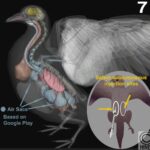
The sterile saline I purchase comes in clear, 500ml plastic IV drip bags. Their rubber stoppers were not designed for more than a single needle penetration. So when the bags arrive, I use a 12-gage needle and 60ml syringe to sterilely transfer the bag’s contents to 5 ml no-additive sterile tubes. My local lab saves me the ones that are near their expiration date. After filled to the 4 cc (milliliter) mark, I place them in my freezer, thaw them as needed and allow them to warm to room temperature before use.
In near-death dehydration situation in mammals, superficial veins are collapsed and quite hard to successfully insert a needle into. In those cases, I give the fluids in the abdomen (intraperitoneally) and concentrate on oxygen and body temperature support until they have time to give an effect. Occasionally, I will cut down on a vein of the fore or hind leg, insert an IV catheter and begin a slow IV drip. Injectable fluids always need to be injected slowly. Too rapid a rate overloads the circulatory system and lungs, which is often fatal.
In near-death situations in birds, I usually give the fluids by drill-spinning a spinal or 1.5″ hypodermic needle into the hollow ulnar bone of their wing. You can see how that is done in the first photo. In an experiment giving fluids in that manner to healthy pigeons, over 50% of the injected fluids had passed from the bone space to the bloodstream within 30 seconds. (ask me for Lamberski1992 ) The second two photos are how I give those fluids directly into a vein of the wing or leg. I much prefer administering it through the bone, as in the first photo. The veins of birds are extraordinarily thin. In dehydrated birds they tend to leak and form a large blood blister (hematoma).
The information you find in books, lectures and on the Internet regarding wildlife dehydration treatment are only general guidelines. Body rehydration is an extremely dynamic process. No two cases are identical, and where fluids reside in the animal’s body changes from moment to moment. So you need to remain “on your toes” (observant) and modify your hydration plan based on what you see occurring – not what I or someone else suggests. With time you will learn to sense when things are improving and when they are not. Some wildlife rehabilitators give dehydrated wildlife of all species 3.3% of its initial body weight, three times during its first 24 hours of hospitalization and then 2.5% three times a day for the next 2–3 days. It has been suggested that otherwise health but severely dehydrated children receive 60–100 ml/kg of intravenous fluids in their first 2–4 hours after admission.
The downside of dehydration in nursing and nestling wildlife is that it is more commonly life-threatening than in adults. The upside is that immature animals accept the human contact needed to nurse them through it more readily. The upside of dehydration in more adult animals is that they often have the body reserves required to survive dehydration. The downside is that the stress and struggle necessary to treat them for dehydration can be as life-threatening as dehydration itself.
Overheating Hyperthermia In Wildlife
Situations that cause dehydration in wildlife often cause excessive exposure to the heat of the sun as well. It doesn’t have to be a traditional heatstroke or a near-coma situation. Whenever an animal’s core body temperature rises even a degree over normal, pathology begins to occur.
No one has studied the results of excessive core temperature (hyperthermia) in wild mammals. But in dogs and cats whose normal body temperature is 101.0 to 102.5° F (38.3 to 39.2° C), a body temperature only a degree higher results in blood flow changes and nervous system issues. The risk goes up as outdoor humidity levels rise. The most sensitive organs to hyperthermia tend to be the brain, kidneys and the blood clotting mechanisms (DIC). In wild mammals, disorientation and panting are likely to be the first thing you notice. In extreme cases, seizures occur as well. But internally, other undesirable changes such as lactic acidosis and generalized inflammation are occurring as well. (read here)
When Overheated / Hyperthermic Birds Arrive
The naturally high body temperature of birds put them near the level where DNA damage and misfolded (denatured) body cell proteins occur. (read here) That is one reason why overheating and heat stroke damage is so common in baby birds that fall from their nests in summertime. Overheating occurs in mature birds as well. But those birds usually come in with underlying health issues. Birds were designed to operate at metabolic temperatures considerably higher than mammals. The smaller the bird species, the higher their core (most inner) body temperature tends to be. As an example, a starling’s daytime core body temperature is about 42.5 C (108.5 F), while its roosting body temperature is about 39.5 C (103.1 F). The cellular and metabolic processes that occur in birds and mammals are all temperature dependent. And all stop working properly when the animal’s body temperature is too high or too low. The risk of serious overheating damage is so much greater in birds than in mammals because their metabolism naturally occurs at temperatures closer to the top safety limits. In that situation, even a small increase in their body temperature can cause irreversible damage and death. Their naturally high body temperature also make birds more prone than mammals to heat stress in high-humidity situations, where their skin’s evaporative cooling mechanisms are less effective. For an adult turkey, for example, a temperature of 29.4 C (85 F) when humidity is above 50 percent places it in the heat stroke danger zone. At 32.2 C (90 F) and 50 percent humidity, its heat stroke risk is extreme.
What Are The Signs Of Overheating Hyperthermia In Birds?
No one has accurately described the signs of hyperthermia in wild birds. In domestic poultry they include labored open-mouthed breathing, panting, pale combs and wattles, wings lifted away from the body, lethargy, diarrhea, seizures and convulsions, so in wild birds they are probably quite similar when they occur.
What Treatment Options Do I Have?
I treat birds that I suspect have overheated with a cool environment. If they still have the ability to perch, I occasionally mist them off with a cool water spray. I give them the same subcutaneous fluids I give to dehydrated birds, but I add dexamethasone at 7.5 mg/kg to the fluid for its anti-inflammatory, anti-shock effect. Although the long-term use of dexamethasone has many undesirable side effects, its half-life in birds is less than one hour. Given subcutaneously or intramuscularly the drug is well absorbed, for reasons unknown, intraperitoneally, dexamethasone is ineffective.
I generally add cefazolin, an injectable antibiotic, as well because bacterial toxemia (enterotoxemia) is a common result of heatstroke. (read here) When you have gotten a nestling through an overheating crisis, congratulations. But be aware that it could still have lingering health and survival issues. (read here)
What Are Heat Shock Proteins, And Why Are They There?
That the cells in overheated poultry release specific heat shock proteins (HSPs) was first noticed in domestic poultry in 1984. (read here) Heat shock proteins are now known to occur in all animals subsequent to major stresses of all kinds. (read here) One of the jobs of these proteins is to deliver instructions (chaperone function) that assist the animal’s cells in repairing the DNA damage and protein misfolding within them that was caused by overheating. (read here & here)
Although results have been mixed, some have found dexamethasone beneficial in raising HSP levels. (read here) The photo above is just a method I use to transfer dexamethasone to small sterile test tubes so that I can dilute it to various concentrations.
The Effects Of Drought & Extremely Hot Days On Nesting Success
It is May 20th 2024 in south Texas, where I live. We have been in a multi-year extended spring-summer drought. Very few songbirds, raptors or small mammals have been successful in producing or raising offspring this year compared to years past. Normal food supplies for all species are severely reduced in the RGV. Winds have been excessive. Like many others that have come in, this particular baby white winged dove was severely dehydrated from being on the ground in our broiling sun. Several subcutaneous injections of 5% dextrose, 2% saline revived it, and extra water-diluted formula keep it going for a few days. But it remained hypothermic apathetic and weak. It passed away on day 4 with complete crop stasis. Even after several crop massages per day. Its final day, it weighed 37.7 grams – much too little for a bird with that amount of feather development.

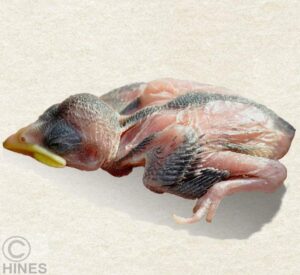
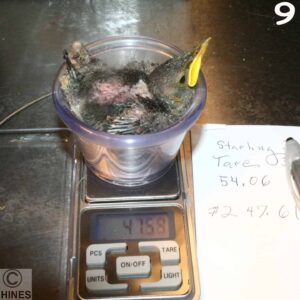
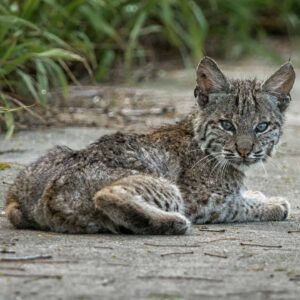
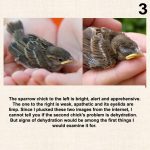
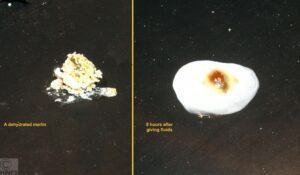
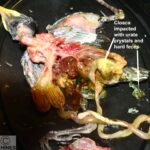

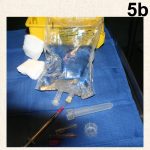
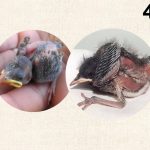
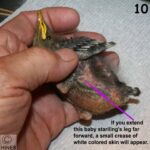
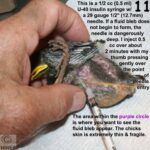

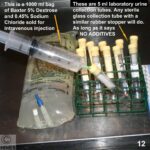
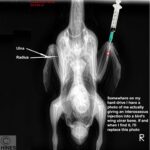
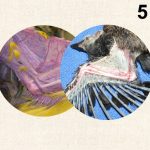
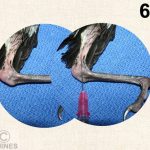
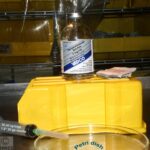
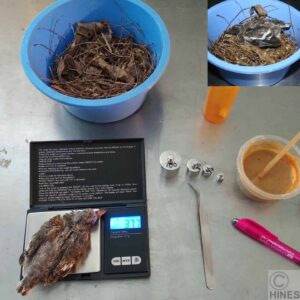
 Dear reader, Besides your donations, Visiting the products that you see displayed on this webpage also helps me pay the costs of keeping these articles on the Web. Best wishes, Ron Hines
Dear reader, Besides your donations, Visiting the products that you see displayed on this webpage also helps me pay the costs of keeping these articles on the Web. Best wishes, Ron Hines